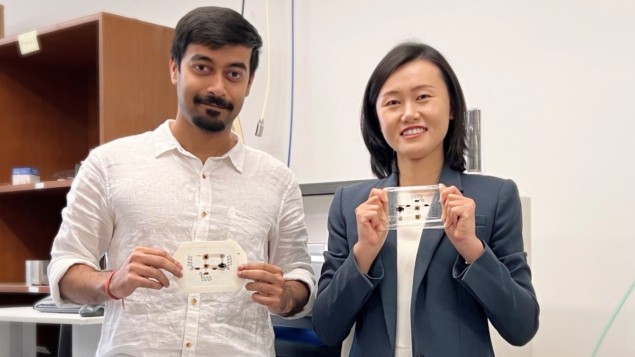
Cardiovascular disease is the leading cause of death worldwide. Continuous cardiac monitoring could allow earlier detection of heart disease, enabling timely intervention to prevent serious cardiac complications. Traditional monitoring devices, however, are designed for clinical settings and are too heavy and power-hungry for long-term measurements of people on the move.
A team headed up at The University of Texas at Austin aims to solve this problem with the creation of an ultrathin (200 µm) and lightweight (2.5 g) device that provides continuous cardiac monitoring outside of the clinic. The stretchable electronic tattoo, or e-tattoo, attaches to the chest via a medical dressing. It boasts ultralow power consumption (less than 3 mW), runs on a small battery with a life of more than 40 h, and wirelessly streams real-time data to a host device such as a mobile phone.
“Most heart conditions are not very obvious. The damage is being done in the background and we don’t even know it,” explains lead author Nanshu Lu in a press statement. “If we can have continuous, mobile monitoring at home, then we can do early diagnosis and treatment, and if that can be done, 80% of heart disease can be prevented.”
Dual-mode electro-mechanical sensing
The e-tattoo works by measuring two key cardiac signals: the electrical activity of the heart via electrocardiography (ECG); and mechanical cardiac rhythm (subtle vibrations caused by heart contraction and blood movement) via seismocardiography (SCG). The ECG sensor interfaces with the body using bio-compatible graphite film electrodes, while the SCG is recorded by a high-resolution, low-noise accelerometer.
Synchronization between the ECG and SCG signals enables the measurement of key cardiac time intervals – the pre-ejection period (PEP) and the left ventricular ejection time (LVET) – with high accuracy. Such time intervals are important indicators of many cardiovascular diseases, but currently can only be measured via invasive means.
“Those two measurements, electrical and mechanical, together can provide a much more comprehensive and complete picture of what’s happening with the heart,” says Lu. “There are many more heart characteristics that could be extracted out of the two synchronously measured signals in a non-invasive manner.”
An e-tattoo designed for long-term wear must be comfortable, conform to the contours of the chest and stretch with the skin as the user moves. To achieve this, the team used serpentine interconnects between the sensors and electronic circuits. They found that the e-tattoo could stretch up to 20% without any damage or drop in signal quality.

Performance comparisons
To validate the quality of the acquired signals, the researchers compared data from the e-tattoo’s sensors against gold-standard clinical devices, observing that both devices captured equivalent signals and data. Next, they tested the e-tattoo on five healthy volunteers, who wore the e-tattoo while holding static poses and cycling under incremental load with breaks. For comparison, participants also wore a non-invasive cardiac output monitor (NICOM).
During the static poses, heart rates measured by the e-tattoo and the NICOM agreed well for all participants, with a difference of 0.07±1.21 beats per minute (bpm). As participants transitioned from lying to sitting upright and then to standing, the e-tattoo recorded increased PEP and decreased LVET, as expected. This demonstrates the device’s ability to measure small changes in cardiac time intervals caused by posture variations.

Graphene tattoo provides cuffless
blood-pressure monitoring
In the cycling experiment, heart rate measurements from the e-tattoo and the NICOM were again highly correlated, with a difference of 0.02±1.24 bpm. The ECG signal remained pristine during cycling, but the SCG signal was corrupted by motion artefacts. Thus the researchers examined the rest periods between each cycling segment, during which the mean difference in LVET between the e-tattoo and the NICOM was −0.44 ± 8.74 ms. This linear relationship shows that the e-tattoo can provide a viable alternative to bulky and expensive clinical monitors.
Finally, the team performed a long-term wearability test with a single subject, who wore the e-tattoo for more than 24 h to demonstrate its use in day-to-day settings. The e-tattoo demonstrated good correlation with a consumer smartwatch in heart rate measurements. Manual inspection of the long-term data showed that during restful segments (such as working at a computer, pausing during a walk or sleeping), the ECG and SCG data were mostly free of motion artefacts and suitable for extracting cardiac time intervals.
The researchers describe the e-tattoo in Advanced Electronic Materials.



